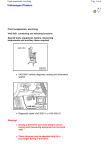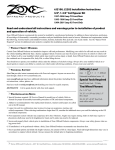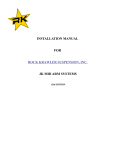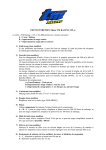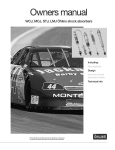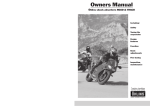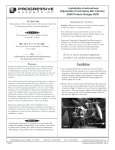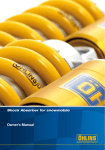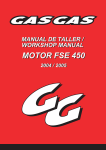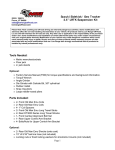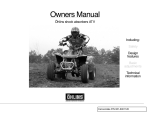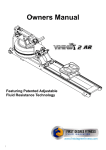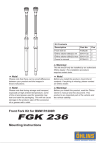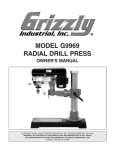Download Suspension Install: B6/B7 Motorsports
Transcript
STāSIS Engineering STāSIS Motorsport Suspension Technical Specification and Installation Manual Damper Model Information Öhlins LMJ Series Damper: Öhlins’ LMJ stock car shock absorbers are based on the race proven Öhlins 46HRC. A shock absorber featuring a large 46 mm piston for quick response, a hose mounted (H) reservoir for better cooling and separate external rebound (R) and compression (C) damping adjusters. Features: • Light weight, aluminum body. • Large reservoir for better cooling. • 2-way adjustable damping. • Quick response for best handling. • Optimum consistency on long runs. • Easy to dial-in, reshim, rebuild and service. 2 Damper Technology – External Adjusters Öhlins shock absorbers have a low speed compression adjustment knob located on top of the reservoir. A low speed rebound adjuster is located at the end eye of the piston shaft. The main bleed valve adjuster (rebound) is easy to access on the piston shaft just above the eyelet. This adjuster is connected to the main bleed valve via an aluminum alloy rod that runs inside the shaft. When the temperature inside the shock absorber increases, the rod expands more than the shaft, further restricting oil flow through the main bleed valve. This system helps prevent fading caused by loss of oil viscosity at higher temperatures. The adjuster mainly affects low speed rebound damping, but has a slight affect on low speed compression damping as well. The temperature compensation system of the rebound adjuster reduces the number of clicks when the shock absorber is hot. Therefore, always make changes from a previous click position without closing the adjuster. To count the number of clicks you are using, first let the shock absorber cool down to ambient temperature. Damper Adjustments – FRONT AND REAR REBOUND Adjustable REBOUND Damping: Damping is set with the knobs that have a normal right hand thread. By turning them clockwise the damping action is increased, and by turning them counter clockwise it is reduced. The knobs have definite positions with noticeable "clicks", making it easy to count to the right setting. The setting knob is located at the bottom on the piston rod (Fig. to the right). It can be adjusted in about 40 steps. All adjusters have a normal right-hand thread. Click position zero (0) is when the adjusters are turned clockwise to fully closed (maximum damping). 3 Damper Adjustments – FRONT COMPRESSION Adjustable COMPRESSION Damping: The compression damping knob is located at the end of the reservoir. This can be adjusted in about 25 steps. The knobs have normal right hand thread. By turning clockwise it increases the damping action and counter clockwise it reduces it. The knob will have definite positions with noticeable "clicks", so it is easy to count to the right setting. All adjusters have a normal righthand thread. Click position zero (0) is when the adjusters are turned clockwise to fully closed (maximum damping). 4 Damper Adjustments – STaSIS Settings The following table represents the base settings for various conditions, fine tuning may be required to reach the best setup given the users specific needs. All STaSIS Motor Sport damper kits are delivered with the “Aggressive Street” setting. AUDI B5 / C5 Performance Street Aggressive Street Performance Track AUDI B6 / B7 Front Shaft 12 Front Reservoir 15 Rear Shaft 24 Front Shaft 12 Front Reservoir 15 Rear Shaft 26 8 10 16 8 10 16 5 5 10 5 5 12 5 Shock Absorber Technical Details – Compression and Rebound Strokes Compression Stroke: During a compression stroke, path 1, fig. 1 is closed and the oil can only flow through paths 2 and 3. The damping forces at different compression speeds are determined by the flow restrictions in these paths. The restriction of flow through path 2, fig. 1 is determined by how much the oil pressure can open the compression shims which are closed shut whenever the pressure is too low or the shock absorber is not in compression stroke. These shims’ resistance to opening are determined by their numbers, thickness and diameters, and are carefully chosen to give the optimum set-up. Path 3, fig. 1 is the main bleed valve. The larger the valve orifice, the more oil will flow through path 3 resulting in lower compression forces. Rebound Stroke: During a rebound stroke the oil flows in the opposite direction. Path 2, fig. 2 is closed and oil can only pass through paths 1 and 3. Damping forces are determined by the flow restrictions in paths 1 and 3. The flow restriction through path 1 is determined by how much oil pressure can open the rebound shims which are shut closed whenever pressure is too low or the shock absorber is not in rebound stroke. Path 3, fig. 2 is the main bleed valve. The larger the orifice, the more oil flows through path 3, making main valve rebound forces lower. 6 Shock Absorber Technical Details - Driving Low Speed Compression and Rebound: When driving on a smooth surface and the shock absorber is compressed slowly (turning g-loads), the damping oil is only forced through the adjuster valve in the piston shaft, fig. 1 flow 3. The oil displaced by the piston shaft going into the damper is forced through the independent compression damping adjuster out into the external reservoir, fig. 2 flow 3. The floating piston in the reservoir is forced to move, compressing the gas by the oil displacement of the piston shaft. When the shock absorber extends (rebounds), the pressure behind the floating piston forces the oil through a one-way valve in the reservoir, and back into the shock absorber body, fig. 4 flow 2 and 3. The oil flow returning through the piston follows the same path through the adjuster valve, fig. 3 flow 3 High Speed Compression and Rebound: When hitting a bump, the shock absorber is compressed quickly (high shaft speed).The pressure on the compression side increases too fast for all of the oil to flow through the adjuster valve and opens the shim stack covering the orifices in the piston, fig. 1 flow 2. As the quick increase in pressure reaches the reservoir, a shim stack parallel to the compression adjuster needle valve opens, fig. 2 flow 1 and 2. The floating piston is forced to move, compressing the gas by the oil displacement of the piston shaft. When the shock absorber extends quickly, the floating piston forces the oil through the one-way valve back into the shock absorber body, fig. 4 flow 2 and 3. The pressure differential over the piston remains high and the shim stack covering the rebound orifices in the piston also opens allowing the oil to return, fig. 3 flow 1. 7 8 Shock Absorber Technical Details – Damping Curves At low shaft speeds the damping oil is forced through and adjustable bleed valve in the piston shaft. The valve primarily controls rebound damping and has only a minor affect on compression damping. The adjuster is connected via an aluminum shaft that runs inside the piston shaft. When the temperature in the shock absorber increases, the shaft extends and gradually closes the bleed valve. This diminishes the influence of oil viscosity changes due to temperature, keeping the flow through the valve virtually the same, regardless of temperature. Compression damping can be adjusted using the second adjustable bleed valve (located on the top of the reservoir). The valve restricts flow to the reservoir, not from it, thereby influencing the compression damping. At higher shaft speeds, damping forces are primarily controlled by the main piston and its compression and rebound shim stacks. By changing the number, diameter and thickness of the shims in the stack, and by using different jets in the valves, STaSIS has customized the dampers to suit your vehicle. *All images and technical content are used courtesy of Öhlins. 9 STaSIS Motorsport and Signature Line Suspension Limited Warranty Limited Warranty Stasis Engineering warrants its line of Ohlins based Motorsport and Signature Line suspension kits against manufacturing and material defects for the lifetime of its operation to the original retail purchaser (referred to as “consumer” herein). This warranty cannot be transferred to another individual or entity and is limited to the following listed terms and conditions• • • • • • • • • • • Included Warranty Card must be returned after installation for warranty terms to be in effect. If no warranty card is on file for the consumer requesting the warranty, all terms will be null and void. Lifetime warranty covers all parts against manufacturing, material, and workmanship defects. Corrosion damage due to environmental conditions is not covered under the lifetime warranty. STaSIS Engineering highly recommends consumers coat the entire damper with a lubricant-protectant spray after installation. STaSIS recommends using Boeshield T9 lubricant-protectant, a spray application which forms a resilient waxy coating on the assembly after drying. This spray is available for purchase directly from STaSIS or any Sears retail outlet. Seal Heads are considered a high wear item and are not covered under the lifetime warranty after installation and initial use. To maintain the lifetime limited warranty policy, STaSIS Engineering requires an annual (1 year) or 12,000 mile service interval for every Motorsport damper and a bi-annual (2 year) or 25,000 mile service interval for every Signature Line damper. o Consumers must schedule service directly with STaSIS Engineering, parts must be returned with a STaSIS issued RMA number which is issued when scheduled. o Service consists of a complete overhaul of 2 front and 2 rear dampers. Overhaul will include a complete disassembly and inspection of all dampers, replacement of all seal heads, and fluid change for all dampers. Cost to consumer - $399.00 plus any applicable shipping charges. o Consumer will be advised of any added costs from worn or damaged parts requiring replacement before re-assembly. Warranty requests for dampers that have not been serviced within the past 12 months (Motorsport) and 24 months (Signature Line), will incur an automatic service charge of $399.00. Warranty will not cover any damaged component due to installation/removal damage, vehicle accident damage, incidental debris or rock contact, and/or curb impact. Wear items – damper shafts, damper bodies, damper pistons, shims, glide rings, and end-eyes will be covered under warranty for wear and tear for a maximum of 4 years from the date of purchase, providing all annual service requirements have been met. STaSIS Engineering reserves the right to make changes to the design of the assembly without assuming any obligation to modify or update any products previously manufactured. All warranty and service claims will be completed on a first come first serve basis. Claims will be turned around in a maximum of 3 business days with the exception of parts non-availability. Warranty will be honored based on the evaluation and the discretion of STaSIS Engineering. All warranty requests honored by STaSIS will include all return shipping costs at the calculated ground shipping rate. If expedite service is requested, customer must cover the cost difference. INDEMNIFICATIONS: Customer agrees to indemnify, hold harmless STaSIS, the STaSIS authorized dealership, and Audi of America against any and all claims, actions, and damages including injuries to persons and/or death or disease arising or alleged to arise, in whole or in part due to the performance enhancement of the vehicle. 10 STaSIS Motorsport and Signature Line Suspension Limited Warranty EXCLUSIONS: STaSIS only warrants parts sold in, and installed on, automobiles built to United States and Canada specifications. “Defects in material and workmanship” shall not include the effects of normal wear and tear of a part installed on a performance-enhanced automobile. This Limited Warranty is void if STaSIS or its designated representative determines that the STaSIS part has been subjected to alteration, neglect, misuse or abuse; if any repairs have been attempted by anyone other than STaSIS or its designated representative; or if failure is cause by accident, acts of God or other causes beyond the control of STaSIS. Neglect, misuse and abuse include any installation, operation or maintenance of the automobile or part not in conformity with the instructions contained in the documentation provided with the automobile and part or otherwise available from automobile manufacturer or STaSIS. LIMITATIONS: No agent, dealer, distributor, service company or other party is authorized to change, modify or extend the terms of this Limited Warranty in any manner whatsoever. DISCLAIMERS: STaSIS and its representatives shall not be liable for any injury, loss, cost or other damage, whether incidental or consequential, arising out of any defect covered by this Limited Warranty, including, without limitation, towing charges, rental car fees, labor for installation and removal of the product(s), loss of use of the automobile while it is being repaired, or damages resulting from the enhanced performance of the automobile, even if STaSIS has been advised of the possibility of such damage. The liability for materials and workmanship of STaSIS under this Limited Warranty, if any, shall not exceed the sum of the original amount paid for the defective product and the MSRP of all OEM parts for which the product directly affects. These disclaimers shall be equally applicable to any service provided by STaSIS or its designated representatives. LEGAL RIGHTS: This Limited Warranty gives purchasers of STaSIS parts specific legal rights. Purchasers/consumers may have other rights which vary from state to state. Some states do not allow limitations on how long an implied warranty lasts, so this limitation may not apply. 11 STaSIS Engineering B6 B7 MotorSport Suspension MS Suspension Kit Parts List Qty Description 2 2 Ohlins LMJ Damper Remote Reservoir Ohlins Rear LMJ Damper internal reservoir Canister Mounting Brackets Front shock clevis Front Upper Stud M12 X 1.25 Nylock 10” x 2.5” Springs 6” x 2.25” Springs Rear Upper Stud Lower Spring Perch Spacers, Rear Lower Long Spacers, Rear Lower Short DRC Line Caps (RS4 Only) UHWMPE Spacer, 2.25” Perch Wrench 2 2 2 2 2 2 2 2 2 2 4 2 2 Part Number SA02.2003.00 SA02.2004.00 SA01.3016.00 SA02.3110.00 SA02.3102.01 HA03.0107.00 SA02.3102.00 SA01.3008.00 SA02.3103.00 SA02.3105.00 SA10.0001.00 SA01.3001.00 Special Tools Required Qty 1 1 1 1 1 1 1 1 Description Part Number Torque Wrench Torque Wrench Engine/transmission jack Spring Compressor Spring holder Spreader Pliers Tensioning strap VAG 1331 VAG 1332 VAG 1383 A VAG 1752/1 VAG 1752/7 3424 T40067 T10038 12 B6 B7 MS Suspension Installation Instructions Please read ALL instructions prior to attempting installation. Please torque all fasteners to specifications. Torque Values Front damper to upper mount Front damper upper mount to body Front lower clevis to lower link Front upper link pinch bolt Front sway bar link to lower control arm Front sway bar link to sway bar Lower spring perch set screw Rear damper to upper mount Rear damper upper mount to body Rear damper eye to lower control arm Rear subframe assembly to chassis OEM wheel bolts * Must be tightened with vehicle at or near ride height. Ride Heights Recommended Front perch setting Recommended Rear Perch Setting 9 ⅝” installed spring height (600 lb spring) 2.25” bottom of perch to spring seat (1000 lb spring) For higher spring rates: Front - add 1/8” (0.125”) for every 100lb increase to the spring rate. Rear – subtract 1/8” (0.125”) for every 100lb increase to the spring rate. 13 37 ft-lbs 56 ft-lbs 66 ft-lbs* 29 ft-lbs 30 ft-lbs + ¼ turn 30 ft-lbs + ¼ turn 10 in-lbs 20 ft-lbs 26 ft-lbs 85 ft-lbs 65 ft-lbs 89 ft-lbs Front Removal 1 Before removing any parts, park the car on a secure, stable, and level surface. Remove wheel trim; pull trim cap off light-alloy wheels (using puller in vehicle tool kit) and loosen (but do not remove) the wheel lug nuts. Jack the vehicle up, and place the car on four stable jack stands or use a professional vehicle lift. We recommend having two people available for certain steps of the installation. 2 Remove wheels 3 Before removing left suspension strut, remove headlight range control link from track control link. 3a RS4 Only: Remove DRC fittings and cap with STaSIS supplied line caps, front and rear (total qty. 4). 4 Remove and discard spring clip – 1 – on the underside of the suspension top plate (this can be done with a pair of side cutters and/or prying it off with a screwdriver -remove lower shock clevis bolt. Remove upper ball joint pinch bolt – 2 – and remove ball joints from upright (light tapping with a mallet may be required to free ball joint studs). 14 5 Unscrew hex bolt – arrow – connecting OE damper fork to lower control arm. 6 Perform steps 2 - 5 on both sides of the car and then open the front hood to complete steps 7 – 9. 7 Unclip plenum chamber cover – 5 – and remove it. 15 8 In the engine bay, • remove rearward hood seal and rain tray • remove retaining screw for coolant reservoir, lift coolant reservoir out of mounting tabs at rear of tank and move slightly to the side. Disconnect level sensor plug from bottom of tank. 9 Remove the suspension top plate mounting bolts – 1 – (three on each side). Remove shock/spring/top plate assembly from vehicle. The following steps can be completed with the front dampers off of the car. 16 10 Remove OEM damper and spring from upper mount. Use an adequate spring compressor to compress spring on shock assembly. VAG tools are pictured here. You may also use a deep socket and vice-grips with a hex key holding the shaft in place. Note: You will not reuse the OEM bumpstop, the thick washer, and the nylock nut that sits on top of the damper shaft. 11 Remove shock shaft nut and separate shock and spring from top plate and rubber isolation mount. The following parts will be transferred to the new damper: #2 Shock Strut Mount #4 Upper Suspension Mount 17 12 Remove swaged aluminum upper spring seat retainer. Use a small chisel and hammer to bend over swaged lip. 13 Place stud mount of the Stasis/Ohlins damper through the opening in the center of the suspension top mount plate. 18 14 Place rubber isolation mount on stud of the Stasis/Ohlins Damper and secure with the new M12x1.25 nut. The top plate will be loose on the damper assembly. This is normal; it will be secured when bolted into the chassis. CAUTION – DO NOT grab damper shaft with any tools while tightening the nylock nut. 15 Installation is the reverse of removal. Note: Bonded rubber suspension bushings can only be turned to a limited extent. All mounting bolts of the suspension links must only be tightened when the suspension is compressed to the curb weight position. Canister Installation Banjo bolt torque: 12ft-lbs NOTE: these are basic recommendations meant to ease installation. Final installation and mounting location is at customer's discretion Things to remember: • Mount canisters and tethers away from heat sources like exhaust and turbochargers • Protect tethers against chaffing / rubbing against other surfaces • DO NOT loosen banjo fitting on damper or canister, doing so can will cause poor or irregular performance • Make sure that the adjuster on the canister is easily accessible when choosing a canister mounting location • Wrap canisters with tape during installation to prevent 19 scratches/damage 16 Loosen plastic steering arm surround. Pass canister through plastic steering arm surround and through the steering arm opening in the chassis. RS4 Only Remove left and right inner CV grease / heat shield (this will provide additional working room when trying to pass canisters in to engine bay). Remove airbox cover (2 screws at top of airbox, MAF sensor plug, intake boot hose clamp and vent hose clip) 20 Remove left and right, outer most steering rack heat shield screws. 17 Carefully pull the canister through and bring up to the top of the firewall to mount. NOTE: Two people may ease canister installation. 18 Cannisters are attached to chassis using the 8mm socket head bolts that attach OE chassis stiffening bar. using supplied STaSIS Ohlins canister mounts and brackets, Adequate slots will need to be cut in engine bay firewall to allow damper hoses to pass to adjacent side of firewall. Take care to remove all sharp edges that may damage damper hoses and / or fittings. 21 Passenger Side Drivers Side 19 Cabin air filter cover will need to be trimmed as shown to provide canister clearance. 22 Rear Removal 1 Securely support both rear corners of the car, relieving tension on the swaybar. 2 Remove wheels If you have the factory spring tensioner and spring holder (VAG 1752/1 and VAG 1752/16) then move directly to Step 6 (and ignore Step 13). 3 4 If you do not have the above tools then complete Steps 3 – 5 and skip Step 6. Support rear subframe assembly as shown Remove rear subframe bolts, one side only. CAUTION! Only remove subframe bolts one side at a time, make sure two are securely retaining subframe at all times 23 5 Gently lower rear subframe assembly with jack. CAUTION: if subframe is lowered too far damage to brake line may occur. Remove rear spring and lower spring seat isolator. 6 Insert spring tensioner VAG 1752/1 with spring holder VAG 1752/16 in coil spring. If necessary, insert spring holder in individual windings and then screw in place with spring tensioner. Take care not to damage trapezoidal link while doing this. *Note* four windings must be tensioned. 24 7 Remove nut – 1 – and corresponding bolt. 8 Remove fender liner retaining screws around damper to access upper damper mounting bolts. Remove bolts – 2 – (above diagram). 25 9 Remove hex nut – 1 – from upper damper mount, separate damper. Save hex nut – 1 – and upper damper mount – 2 – for reassembly. 10 Assemble new rear damper into mount as shown. 26 11 Install new Ohlins rear damper assembly into vehicle. (note the spacers for the lower damper mounts are offset, the longer of the two bushing will fit into the register on the suspension upright). CAUTION! it is important to loosen and re-torque the lower fastener (#1) with the suspension at final ride height to avoid premature bushing failure. 27 12 Install Stasis adjustable spring seat and white spring isolator Tighten the three grub screws on the Stasis lower spring perch using a 3mm hex key. Failure to tighten these screws may cause difficulty adjusting ride height Place rear 2.25" spring with OEM upper rubber isolator onto STaSIS adjustable perch. Perch is set to recommended height prior to shipping. 13 Slowly raise subframe and reinstall subframe bolts. Thread subframe bolts by hand for the first few turns to avoid cross-threading. 28 STaSIS Ohlins Ride Height Adjustment Ride height inspection and adjustment procedure: 1. After completing installation of the kit, set the vehicle on the ground and drive the car around the block to settle the suspension. To take ride height measurements MAKE SURE THE VEHICLE IS PARKED ON A LEVEL SURFACE. VERY IMPORTANT! 2. Measure the ride height of the vehicle at four points for future reference. Measure from the center of the wheels to the bottom of the fender lip. 3. If you are pleased with this ride height, save the measurements for future reference. Make sure the vehicle does not have a positive rake (measured from the front and rear of the door sills to the ground, not the measurement in step 2), vehicles should be level. If ride height changes are required, continue to step 4. 4. Calculate the difference between the actual ride height and the ride height you would like the car to sit at for the right front wheel. For optimum handling we recommend this be done with the driver in the car and ¾ of a tank of fuel. We recommend that the distance between the center of the wheels and the bottom of the fender lip is not set below 13.0 inches. The suspension is operating too close to its maximum bump travel and handling can be negatively impacted. 5. For most Audi vehicles, the ratio between the front shock body motion and wheel motion is about 0.65 to 1 and the rear is 0.80 to 1. This means that the wheel travels about 1 inch for every 0.65 inches of shock body travel on the front and 0.80 inches of spring travel on the rear. Therefore, for example, if you wanted to lower the car ½ inch from its current ride height at the right front wheel, then you would have to lower the lower spring perch on the right front shock body by ½ x 0.65 = 0.32 inches. The rear motion ratio is calculated the same way. 6. The thread for both the front and rear spring perches is 1.5mm (0.06 in) per 1 rotation. Repeat the calculation steps 4 & 5 for all four wheels. 7. Armed with the data from steps 4,5 & 6, securely jack the car up and place it on four jack stands. Remove the wheels if necessary to reach the lower spring perches. For the front dampers, loosen the lower perch lock ring and thread the lower perch up or down by the amount you have calculated in step 5. The rear spring perch does require a locking ring and can be turned freely. For B6 and newer chassis models, the rear spring perch can be difficult to turn. To ease spring pressure on the perch we recommend loosening the two subframe bolts to lower the subframe assembly on each side (DO NOT loosen all 4 subframe mounting bolts at once as this will affect wheel alignment). Record the location of the perches so you can have it as a future reference if needed. Once the desired height is attained, lightly tighten until snug all locking perches against the spring perch (do not overtighten or rings will be difficult to adjust in the future). 8. Place the wheels back on the car and lower it to the ground. The vehicle will sit high, you must drive the car around the block before any measurements are taken. Go to step 2, make sure the car is in the exact same location as before and press up and down on the car 3 or 4 times at each of the four wheels to settle the suspension before you make any measurements. After you are completed with ride height adjustments a 4-wheel vehicle alignment is highly recommended. 29 STaSIS Ohlins Maintenance Instructions Custom Valved Ohlins Threaded Steel Dampers The STASIS Coil Over kit is designed to provide superior service for the lifetime of your vehicle. As this suspension system is a race car derived kit with high performance components, routine maintenance is required to insure the optimal operation of your suspension system. We recommend the following steps are performed annually, preferably before and after the winter season. Vehicles that are exposed to more abusive environments, such as sea salt, road salt or dirt roads may necessitate more frequent maintenance. 1. Securely support the vehicle on four jack stands and remove the road wheels. 2. Clean the threaded portion of the damper with a non metallic brush using soap and water. 3. We recommend lowering or raising the lower spring perch to allow access to clean the threaded portion of the damper that is covered by the perches. 4. Lubricate the threaded portion of the damper with “Boeshield T9” lubricant-protectant or a similar wax based lubricant. 5. Return the perches to their original location and lightly tighten the locking perches. Spray protectant on the remaining components of the damper assembly. 6. Check the rear spherical bearings and verify that they are properly lubricated. 7. We recommend servicing your dampers with STaSIS every year to maintain product warranty and optimal functionality. 8. If you have any questions about this, please call STaSIS at 888-9STaSIS. Secure the road wheels and return the vehicle to the ground. Watch that the springs seat properly on the spring perches 30
































